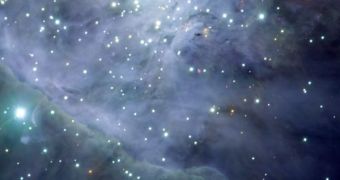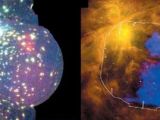What do you see when you look upwards on a clear sky night? A few thousands stars maybe, some of the planets in the solar system, and the Moon... Looks kind of empty, doesn't it? The fact is that our galaxy is mostly cold empty space, as much as the universe. Nonetheless, astronomers from the Paul Scherrer Institut in Switzerland recently found that hot plasma may be circulated from one region of the galaxy to another through empty space, in order to connect isolated clouds of gas of star clusters throughout the galaxy.
The recently discovered plasma funneling phenomenon has been observed with the help of the XMM-Newton X-ray Space Telescope in the Orion Nebula, showing a plasma cloud reaching temperatures up to one million degrees Celsius flowing from the Orion Nebula towards the Eridanus globular supercluster. Previously, astronomers believed that the large gas cloud had been ejected during the supernova explosion of a single massive star, albeit while looking for the source they failed to find any in the Orion Nebula.
Stars in the Orion Nebula are relatively young, most of them less than a few million years old, meaning they emit large amounts of X-ray radiation. By observing multiple such stellar X-ray point sources, astronomers were actually able to see the diffuse emissions of light, evidence of the presence of a large cloud of plasma in the close proximity of the nebula. The fact that it hadn't been observed during previous observations with the Chandra X-ray Space Telescope could be explained by the fact that the plasma was hidden out of sight by a dense cloud of natural gas.
Furthermore, astronomers were also capable to explain the origin of the energy contained in the million degrees plasma cloud. They first studied the possibility that the gas received the energy required to heat up to such extreme temperature from the young stars in the Orion Nebula, but they do not seem capable of providing with that much energy. Alternatively, enough energy could be harnessed from solar winds traveling at high speeds, emitted from the region of the Orion Nebula called the Trapezium, a dense region of space which house a small number of massive stars, providing with most of the light seen in the Orion.
Usually extremely hot plasma remains in the place where it forms, mostly due to the fact that cold gas and dust does not mix with it. But, in the Orion Nebula, the hot plasma and the cold gas and dust surrounding it experience a equilibrium in pressures, which allows it to escape into interstellar space at speeds up to a few tens of kilometers per second. The phenomenon should take place only in regions of space with a high density of massive stars, but the discovery of the hot plasma gas originating from the Orion Nebula proves that it is occurring more often than previously thought.
Manuel G?del from the Paul Scherrer Institut in Switzerland says that extremely hot plasma clouds were observed in the past in regions of space populated by large numbers of massive stars, and most of the material originated from supernova explosions. On the other hand, Orion doesn't have that much massive stars, thus it does not fit the model, meaning that the phenomenon is actually quite common throughout the galaxy.
Hot plasma gas is extremely important to star and solar system formation, as it interacts with cold gas and dust through X-ray emissions, and influences severely the formation of accretion disks around stars by ionizing them.

 14 DAY TRIAL //
14 DAY TRIAL // 
